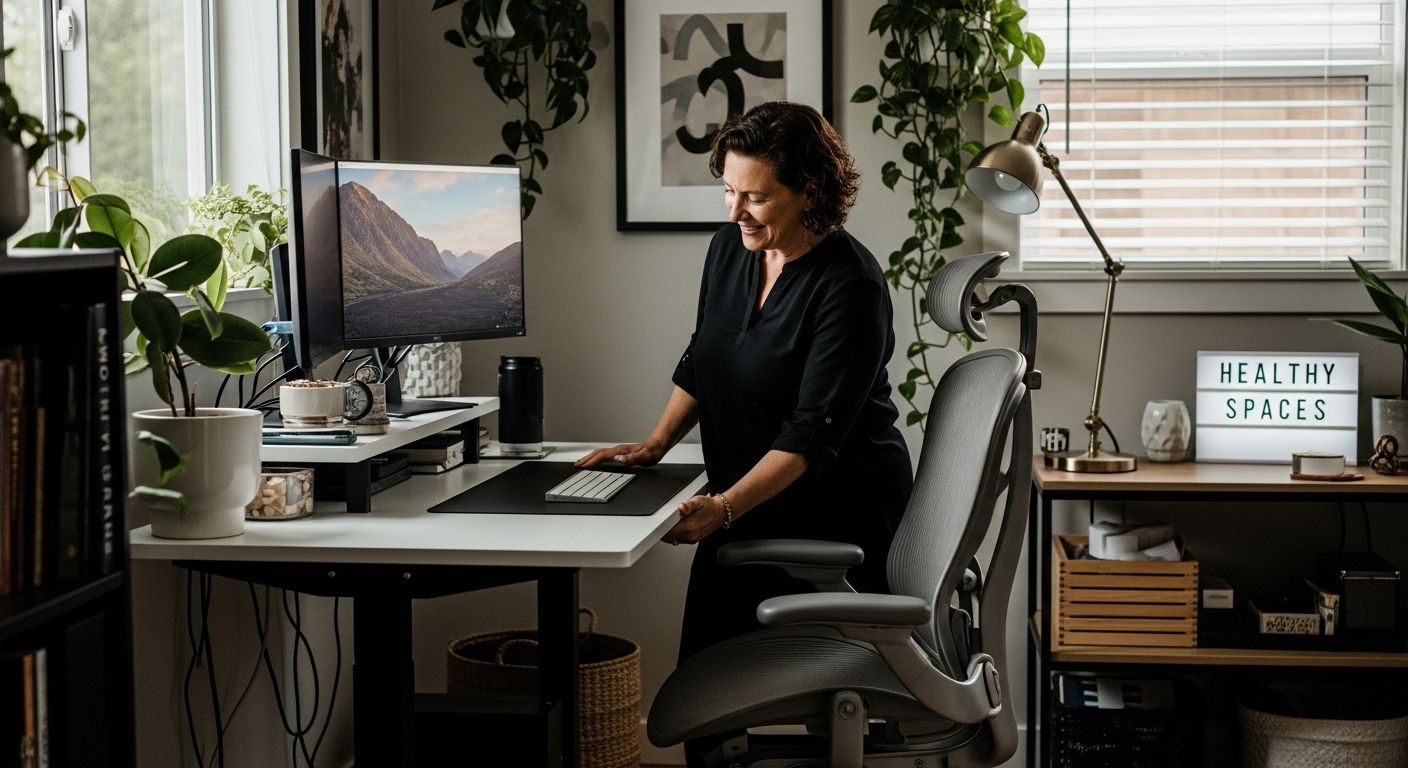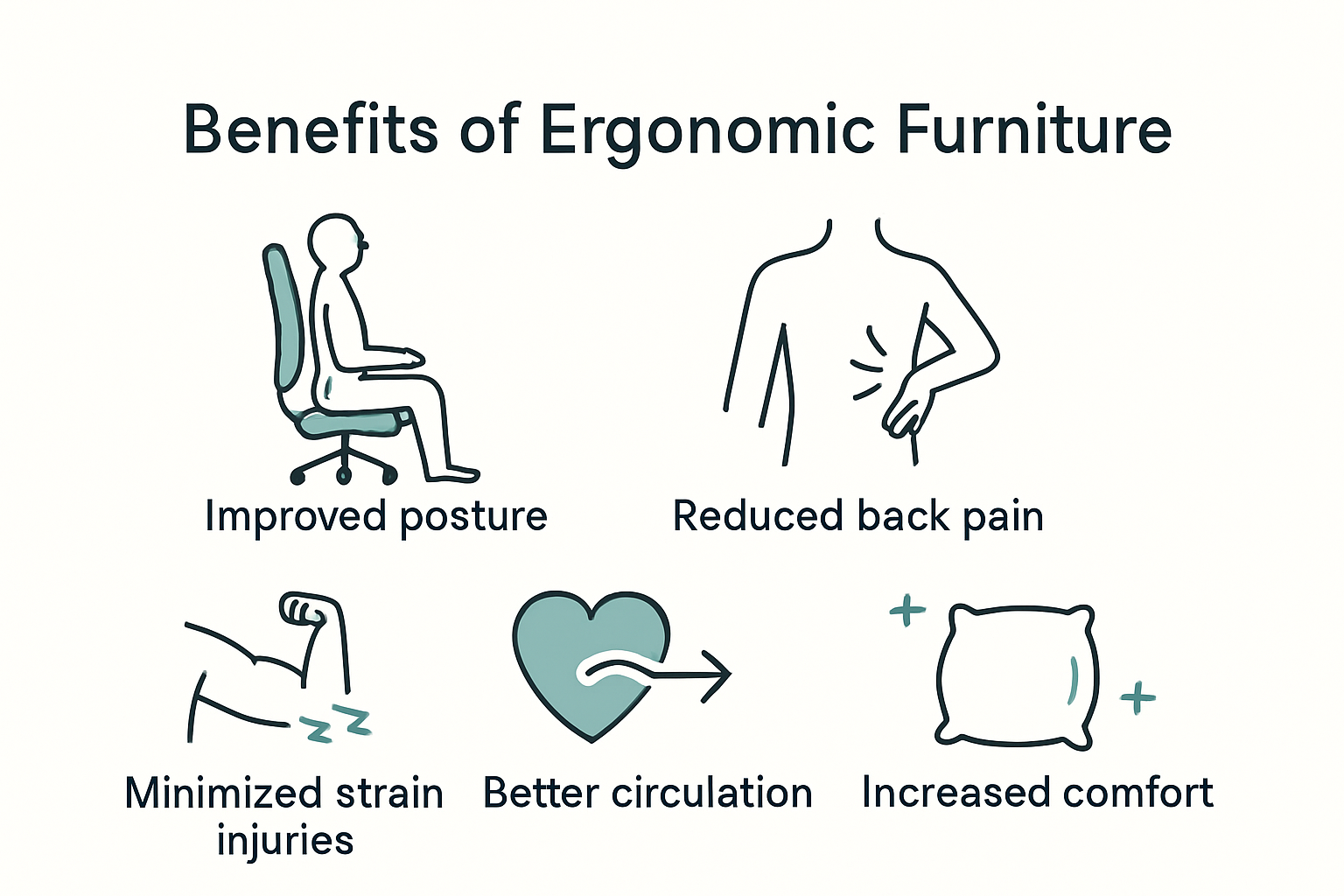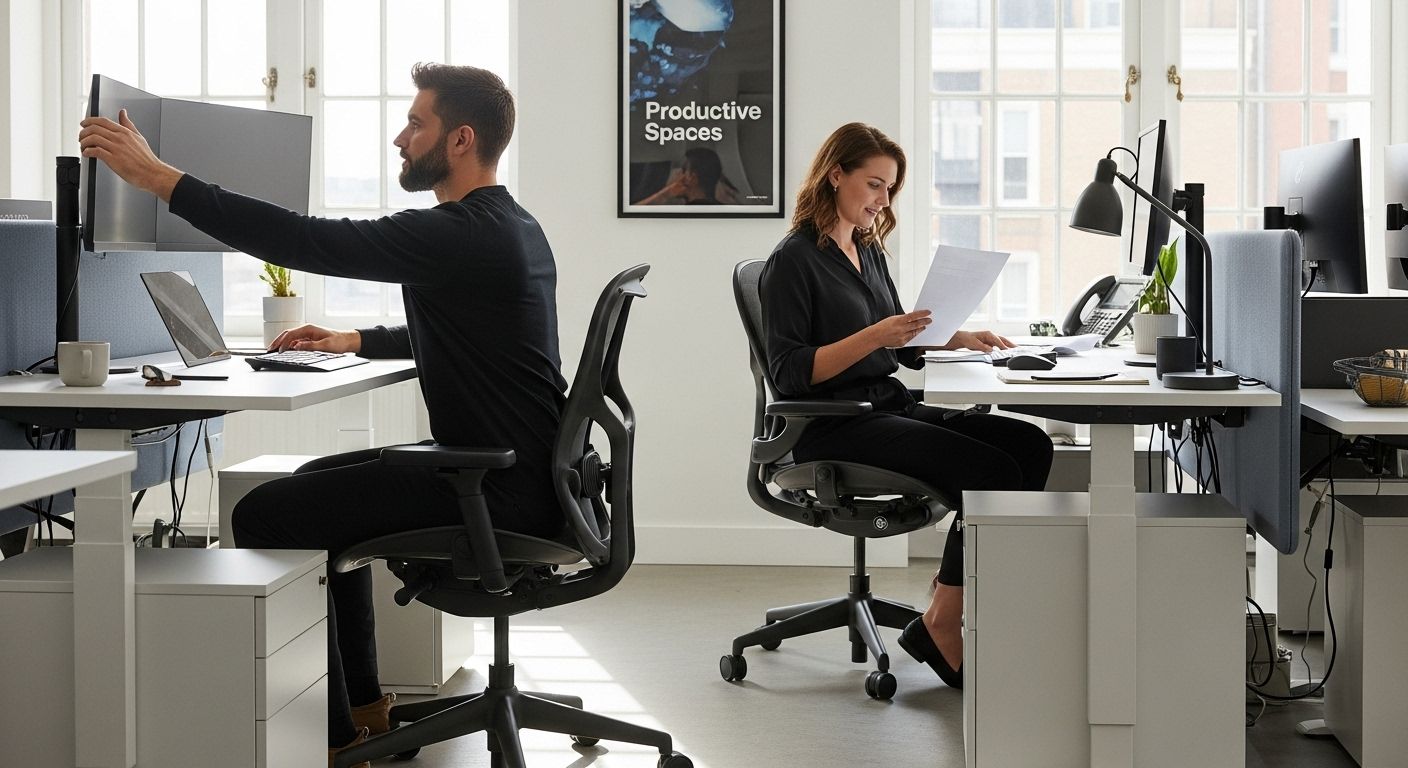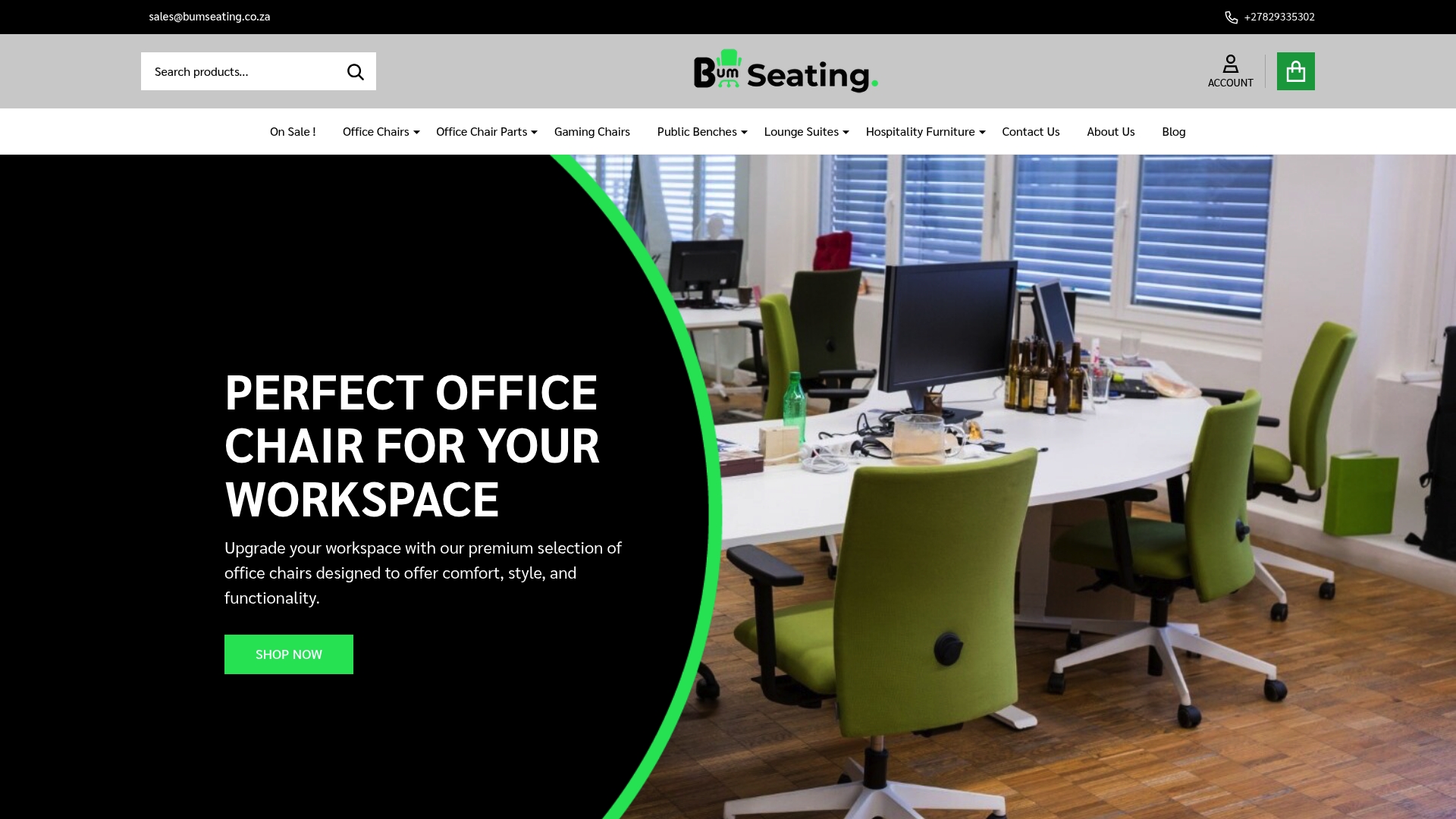Ergonomic Furniture Basics: Your Guide to Healthy Spaces
11th Aug 2025
Ergonomic Furniture Basics: Your Guide to Healthy Spaces

Office hours stretch longer and more people are working from home, so the need for healthy, comfortable furniture has never been higher. Surprisingly, studies show that ergonomic interventions can cut the risk of musculoskeletal disorders by up to 60 percent. Most folks still think a fancy office chair is just for looks, but the real edge comes from proper support and smart design that boosts both your health and your focus.
Table of Contents
- Understanding Ergonomic Furniture Essentials
- Choosing the Right Ergonomic Solutions
- Key Benefits for Work and Home Environments
- Tips for Creating Comfortable and Productive Spaces
Quick Summary
| Takeaway | Explanation |
|---|---|
| Choose customizable ergonomic furniture. | Select furniture that can be adjusted to fit individual body types and work preferences for optimal comfort. |
| Prioritize desk and chair alignment. | Ensure that desks and chairs are positioned to support natural body posture, reducing physical strain throughout the workday. |
| Invest in quality ergonomic solutions. | High-quality ergonomic furniture enhances productivity and reduces fatigue, making it a worthwhile investment for health and performance. |
| Conduct regular ergonomic assessments. | Periodically evaluate your workspace setup to ensure it continually supports your health and productivity needs. |
| Consider holistic space design. | Integrate ergonomic principles into all areas, including home and work, to improve overall well-being and efficiency. |
Understanding Ergonomic Furniture Essentials
Ergonomic furniture represents a critical investment in workplace health and productivity for modern businesses and individuals. At Bum Seating, we recognize that understanding ergonomic furniture basics goes far beyond simple aesthetic choices—it’s about creating environments that support human physiology and workplace wellness.
The Science Behind Ergonomic Design
Ergonomic furniture is fundamentally about adapting workspaces to human bodies, not forcing bodies to adapt to rigid furniture configurations. Research from the University of Washington’s Environmental Health & Safety department reveals that properly designed ergonomic furniture can dramatically reduce musculoskeletal disorders and workplace-related physical strain.
The core principles of ergonomic design focus on several key aspects:
- Adjustability: Furniture that can be customized to individual body types and work preferences
- Support: Providing optimal alignment for spine, neck, and limbs
- Movement: Encouraging natural body positions and subtle movements throughout the workday
Preventing Physical Strain Through Smart Furniture Choices
According to the Cal State LA Ergonomics Program, selecting the right ergonomic furniture involves understanding how different design elements interact with human physiology. Chairs with adjustable backrests that support the spine’s natural inward curve, seats that allow feet to rest flat, and breathable fabric upholstery are not luxury features—they are essential components of a healthy workspace.
The U.S. Department of the Interior’s ergonomic guidelines emphasize a holistic approach that considers more than just seating. Proper monitor placement, desk height, and overall workspace configuration play crucial roles in creating an environment that minimizes physical stress and maximizes comfort.
Ergonomics: An Investment in Human Performance
Beyond immediate physical comfort, ergonomic furniture represents a strategic investment in human performance. By reducing physical strain, these thoughtfully designed pieces can enhance concentration, reduce fatigue, and ultimately improve workplace productivity. Learn more about our ergonomic seating solutions that are engineered to support your body’s natural movements and work rhythms.
For businesses and individuals in South Africa seeking to create healthier, more supportive work environments, understanding ergonomic furniture basics is the first step towards transforming workspaces into zones of comfort, efficiency, and well-being.
Choosing the Right Ergonomic Solutions
Selecting the appropriate ergonomic furniture requires a strategic approach that goes beyond aesthetic preferences. At Bum Seating, we understand that choosing the right ergonomic solutions is a nuanced process involving careful consideration of individual needs, workspace requirements, and physiological comfort.
Understanding Individual Ergonomic Requirements
Research from the University of New Hampshire highlights the critical importance of personalized ergonomic solutions. Not all bodies are identical, which means a one-size-fits-all approach to furniture is fundamentally flawed. Key factors to consider include body height, weight, work tasks, and specific physical requirements.
A comprehensive study published in PubMed outlines essential ergonomic chair requirements that go beyond basic comfort. These include:
- Safety: Preventing potential workplace accidents
- Adaptability: Accommodating at least 90% of potential users
- Comfort: Designing appropriate seat and backrest contours
- Practicality: Ensuring easy-to-use adjustment controls
- Durability: Maintaining structural integrity over extended use
Matching Furniture to Workspace Dynamics
Research published in Heliyon emphasizes the importance of designing furniture based on comprehensive anthropometric data. This means considering not just individual physical characteristics, but also the specific demands of different work environments. A computer laboratory requires different ergonomic solutions compared to a creative studio or a call centre.
When selecting ergonomic furniture, consider:
- Desk height and adjustability
- Chair support mechanisms
- Keyboard and monitor positioning
- Task-specific movement requirements
Investing in Long-Term Workplace Wellness
Ergonomic furniture is more than a purchase—it’s an investment in human performance and health. Check out our comprehensive guide to workspace wellness to understand how strategic furniture selection can transform workplace productivity and employee well-being.
For South African businesses and professionals, choosing the right ergonomic solutions means balancing individual comfort, workspace efficiency, and long-term health considerations. By prioritizing adaptive, well-designed furniture, organizations can create environments that support physical health, enhance cognitive performance, and demonstrate a genuine commitment to employee welfare.
Key Benefits for Work and Home Environments
Ergonomic furniture transcends mere aesthetic considerations, offering profound benefits that transform both professional and personal spaces. At Bum Seating, we recognize that the right furniture can fundamentally improve physical health, cognitive performance, and overall quality of life across work and home environments.
Physical Health and Wellness Advantages
According to the Occupational Safety and Health Administration (OSHA), ergonomic interventions can dramatically reduce muscle fatigue and decrease the severity of work-related musculoskeletal disorders. These benefits extend far beyond traditional office settings, impacting home workspaces, study areas, and creative zones where individuals spend significant time seated.
Key physical health benefits include:
- Reduced Musculoskeletal Strain: Minimizing pressure on joints and spine
- Improved Posture: Supporting natural body alignment
- Decreased Risk of Chronic Pain: Preventing long-term physical complications

Below is a table summing up the major physical health and productivity benefits provided by ergonomic furniture, making it easy to see at a glance how these solutions enhance work and home environments:
| Benefit | Physical Health Impact | Performance Impact |
|---|---|---|
| Reduced Musculoskeletal Strain | Minimises pressure on joints and spine | Allows longer, more comfortable work sessions |
| Improved Posture | Supports natural spine alignment | Leads to better focus and fewer distractions |
| Decreased Chronic Pain Risk | Prevents long-term physical complications | Reduces absenteeism and medical costs |
| Enhanced Concentration | Less discomfort and fatigue | Supports higher cognitive performance |
| Increased Work Efficiency | Diminishes physical strain during tasks | Boosts overall productivity |
| Lower Repetitive Injury Risk | Prevents repetitive stress injuries | Maintains consistent job performance |
Productivity and Performance Enhancement
Research published in the National Center for Biotechnology Information demonstrates that ergonomic furniture directly correlates with increased workplace productivity. When individuals are physically comfortable, they can maintain focus, reduce fatigue, and sustain higher levels of cognitive performance.
Performance improvements manifest through:
- Enhanced concentration
- Reduced physical discomfort
- Increased work efficiency
- Lower likelihood of repetitive strain injuries
Holistic Wellness Across Environments
Ergonomic furniture is not confined to corporate settings. Modern lifestyles demand flexible solutions that adapt to various environments—home offices, remote workspaces, creative studios, and personal study areas. Explore our comprehensive approach to workspace wellness to understand how strategic furniture selection can transform your daily experience.
For South African professionals and home users, investing in ergonomic furniture represents a commitment to personal health, productivity, and long-term well-being. By prioritizing furniture that supports natural body mechanics, individuals can create spaces that nurture physical comfort, mental clarity, and sustained performance across all aspects of life.
Tips for Creating Comfortable and Productive Spaces
Designing ergonomic workspaces requires thoughtful planning and strategic implementation. At Bum Seating, we understand that creating comfortable and productive spaces goes beyond simply purchasing furniture—it involves a holistic approach to workspace design that prioritizes human health and performance.
Workspace Layout and Furniture Positioning
Research from the New York Resource Center highlights the critical importance of implementing ergonomic best practices. The positioning of furniture and equipment plays a crucial role in preventing physical strain and promoting overall workplace efficiency.
Key considerations for optimal workspace layout include:
- Strategic Desk Placement: Ensuring natural light access and minimizing glare
- Monitor Positioning: Aligning screens at eye level to reduce neck and shoulder strain
- Circulation Space: Creating pathways that allow easy movement and minimize physical obstacles
Customization and Individual Comfort
Insights from Tsingapore’s workplace design research emphasize the importance of customizable workstations. Not all bodies are identical, which means furniture must adapt to individual needs rather than forcing individuals to conform to static designs.
Essential customization strategies include:
- Adjustable chair heights and backrest configurations
- Sit-stand desk options
- Personalized accessories like footrests and monitor stands
Ongoing Ergonomic Maintenance
Corovan’s workplace ergonomics guidelines underscore the importance of regular ergonomic assessments. Creating a productive space is not a one-time event but an ongoing process of evaluation and adaptation.
Recommended maintenance practices include:
- Periodic workspace ergonomic assessments
- Employee training on proper posture and equipment use
- Regular equipment and furniture updates
Discover our comprehensive approach to workspace wellness to transform your work environment into a hub of comfort and productivity.
For South African businesses and individuals, creating comfortable and productive spaces is about understanding that every detail matters. By investing in thoughtful design, adaptable furniture, and continuous improvement, you can develop workspaces that not only support physical health but also enhance overall professional performance and well-being.

Frequently Asked Questions
What is ergonomic furniture?
Ergonomic furniture is specially designed to support the body’s natural posture and movements, reducing physical strain and enhancing comfort during work or study.
How does ergonomic furniture benefit health?
Investing in ergonomic furniture can significantly reduce the risk of musculoskeletal disorders, improve posture, and decrease the likelihood of chronic pain, ultimately promoting overall physical health.
How can I determine my individual ergonomic requirements?
Understanding your individual ergonomic requirements involves evaluating factors such as your body height, weight, the types of tasks you perform, and specific physical needs to select furniture that supports your unique physiology.
What are the key features to look for in ergonomic chairs?
Key features to consider in ergonomic chairs include adjustability (height and backrest), lumbar support for spine alignment, breathable materials, and seat depth to ensure comfort and proper posture.
Level Up Your Workspace Comfort Today
Have you ever felt frustrated by persistent aches or struggled to stay focused in an uncomfortable chair? The article explains how poor furniture choice leads to physical strain, fatigue, and lost productivity, especially without true ergonomic support. At Bum Seating, we bring ergonomic furniture basics to life with practical solutions that support your health and help you achieve lasting comfort. Explore our range of modern ergonomic office chairs and accessories built for South Africans who want to work and feel better every day.

Ready to experience the proven benefits of purposeful seating? Start browsing Bum Seating’s online store for work-ready ergonomic chairs, supportive components, and workspace essentials. Make your next workday healthier and more enjoyable—shop now for instant access to competitive pricing and exclusive offers. Take the first step to a productive and comfortable space by visiting https://bumseating.co.za today.
